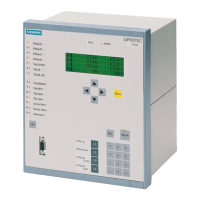'(& )( )'& &) ( &!& ")& &$(( $# Ć %&( $# #)" &&#$
4 - 9
Siemens AG ⋅ May 1998
Fig 4.6 c) illustrates the formation of the measured
value on the assumption that the current flows into a
short-circuit within the protection zone via the current
transformer with the behaviour illustrated under 4.6
a). The stabilization factor k is again assumed to be
0.65. In this case the tripping quantity prevails right
from the beginning of the short circuit. But since the
current transformer saturates, the tripping quantity
disappears after 6 ms; the opposite half-cycle will
have no tripping effect. In the following two cycles, a
tripping condition will only occur for the current direcĆ
tion which is favoured by the offset. As the process
proceeds, the current sets up a tripping condition in
all half-cycles.
A comparison of the measured values in cases b (exĆ
ternal short-circuit) and c (internal short-circuit)
shows, besides a temporary similarity, two essential
discriminating features:
1. After a few cycles - when the DC component has
decayed somewhat - each half-wave, i.e. the curĆ
rent in both directions, delivers a correct measured
value according to the fault location.
2. At the inception of the short-circuit (usually at
least for a quarter of a cycle) the correct measured
value is formed according to the fault location.
These two facts are utilized by the numerical busbar
protection 7SS52 to distinguish between external and
internal short-circuits. This is particularly valuable
when large short-circuit currents and DC components
severely saturate the current transformers forcing the
protection to operate under severely aggravated conĆ
ditions.
A sophisticated combination of the above two distinĆ
guishing features stabilizes the operating characterisĆ
tics of the digital busbar protection 7SS52 even under
extremely difficult conditions, namely:
1. high degree of stability even during current transĆ
former saturation,
2. short tripping times for internal short-circuits,
3. correct behaviour and proper response to evolving
faults,
4. ease of commissioning and determination of setĆ
ting values.
At first glance, the stability in the event of external
short-circuits appears to be jeopardized by the curĆ
rent conditions shown in Fig 4.6 b). The tripping quanĆ
tity markedly exceeds the restraining quantity on two
occasions.
The 7SS52 includes a logic which enables the protecĆ
tion to decide according to the facts outlined above
whether tripping should be initiated after either one or
two measurements.
For normal load currents, the magnetic flux in the curĆ
rent transformer's iron circuit is relatively small. It is
of the order of, at most, a few percent of that value
at which the iron saturation begins. This design
makes the achievement of high overcurrent factors
possible which are needed for the proper behaviour of
the associated relay equipment during large short-cirĆ
cuits currents.
Since the magnetic flux under normal conditions is
low, a certain time will elapse after short-circuit inĆ
ception, even under extreme conditions (very large
short-circuit current, large DC component with a long
time constant) before the magnetic flux in the iron
core reaches the saturation level. This process, in
both conventional current transformers with a closed
iron core as well as in linearized current transformers
with an air gap in their cores, will typically last from a
quarter-cycle to a half-cycle.
Since the current transformers transform accurately
according to ratio before saturation, the secondary
currents during the first milliseconds after inception of
a short-circuit has the most conclusive information.

